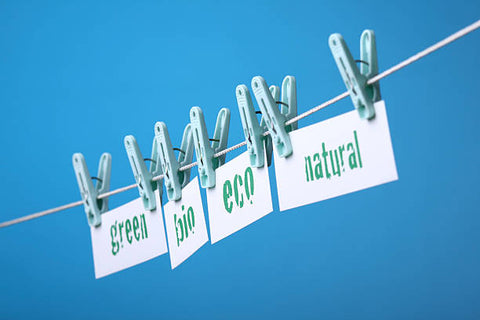
Natural Steps Bath Mats ARE Carbon Neutral – What does Carbon Neutral even mean?
The term 'Carbon neutral' can be confusing. This article will help you understand what it means, both for our product and in a broader context.
At first, I wondered, "How can anything be Carbon Neutral?" Does it mean that renewable energy was used for everything, from getting the raw materials to making the product? That doesn't seem possible, especially if the product has traveled a long way. There aren't many boats, planes, or trucks using green energy.
Turns out, I was right. A carbon neutral product doesn't mean there were no emissions when making it. It means the product's whole life cycle is examined to find out how much carbon pollution is in it, and then the company does something to make up for it. Even a product that's really bad for the environment, like diesel fuel, can be called carbon neutral if the company measures and balances the impact.
Another problem is that it's not always clear how much of a company's activities have been checked and balanced. They measure emissions in different ways, and this can be confusing when a company claims to be 'Carbon neutral,' but they've only looked at some of their emissions.
Carbon Emissions Scopes Simplified
Scope 1 - Direct Emissions: Scope 1 emissions are the gases that come directly from a company's own stuff and activities. This includes things like the energy they use on their property, like natural gas or fuel, emissions from machines they control, and even the fumes from their cars and trucks. It also covers gases released during their manufacturing processes.
Scope 2 - Indirect Emissions: Scope 2 emissions are the gases that come from the energy a company buys from somewhere else, like electricity. Even though they didn't make the energy themselves, they're still responsible for the emissions it creates.
Scope 3 - Indirect Value Chain Emissions: Scope 3 emissions are all the gases that come from things related to the company's business, but not directly under their control. These can be the largest part of a company's emissions. They're divided into two groups:
- Upstream Emissions: These are emissions created while making or delivering the things a company uses, like products, services, or materials. It includes things like transportation, waste, and the energy used to make what the company buys.
- Downstream Emissions: These are emissions caused by the things a company sells, like how they're transported, used, or disposed of after people buy them. It also includes emissions from investments and franchises.
In a nutshell, Scope 1 is what a company directly creates, Scope 2 is the emissions from the energy they buy, and Scope 3 is all the other emissions that are linked to their business, even if they don't have direct control over them.

Buying from a manufacturer vs buying from an importer.
If you are buying from a UK manufacturer, then scope 1 and 2 emissions would tell the consumer quite a lot about the carbon footprint of a company. However, most products are made abroad, often in China and the UK importer rarely includes any of the manufacturer’s emissions, mining and processing of raw materials or transport to UK for the products they resell. If the importer uses a managed warehouse and an outsourced courier they may not even include those factors in their calculations. Only actually including the energy they use in their small marketing office!
Carbon neutral product vs Carbon neutral company
A carbon neutral product is usually more meaningful than a carbon neutral company. As mentioned before, an importer or distributor does not include any of the embedded emissions contained in a product. In our case because we use a 3rd party manufacturer so our Company or corporate carbon emissions are quite low, only 2% of overall. 98% of our impact comes from making the products! So its pretty meaningless being a carbon neutral company vs having carbon neutral products!
What do Natural Steps do?
Natural steps use Climate Partner to assess their product from cradle to grave to scope 3, this includes every stage upstream and downstream from the original mining and processing of the product, to energy used by the manufacturer, material wastage, transport to the UK, our own UK warehousing, transport to the customer, packaging and end of life disposal. There is even an extra 10% buffer added.
Natural Steps are both a carbon neutral to scope 3 company and selling a carbon neutral product measured to scope 3.
Here is a link to the product carbon footprint report (6.11kg co2 in each product).
The following link ClimatePartner contains evidence that the carbon emissions have been balanced and details the project invested in.
A report is produced to identify hotspots in the product and create a plan for reducing the embedded emissions in the process. This is the cornerstone of sustainability, not offsetting. A similar report is produced for the company’s operations.
The final emissions are then balanced (offset) using heavily scrutinised and high quality verified offsetting schemes. We take FULL RESPONSIBILITY

Climate Partner
Our carbon partners understand how ambiguous many of the terms used in this space are. They are rebranding Carbon neutral to Carbon measurement, reduction, implementation, balancing and reporting, a bit more of a mouthful but it clearly communicates what it means. Climate partner are only associated with world class standard of offsetting and partner with a number of major brands in over 100 countries.
Useful resources
Understanding your emissions - https://www.climatepartner.com/en/scope-1-2-3-complete-guide#understanding-your-emissions
Complete guide to Scope 1,2 and 3 emissions - https://www.climatepartner.com/en/scope-1-2-3-complete-guide
Green house gas protocol - https://ghgprotocol.org/about-us#:~:text=Greenhouse%20Gas%20Protocol%20provides%20standards,and%20manage%20climate%2Dwarming%20emissions.
The link between Greenhouse gases and global warming https://www.europarl.europa.eu/news/en/headlines/society/20230316STO77629/climate-change-the-greenhouse-gases-causing-global-warming

Comments (0)
There are no comments for this article. Be the first one to leave a message!